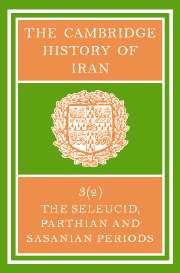Book contents
- Frontmatter
- PART 5 INSTITUTIONS
- 18 IRANIAN SOCIETY AND LAW
- 19 POLITICAL, SOCIAL AND ADMINISTRATIVE INSTITUTIONS, TAXES AND TRADE
- 20 GEOGRAPHICAL AND ADMINISTRATIVE DIVISIONS: SETTLEMENTS AND ECONOMY
- 21(a) TIME-RECKONING
- (b) IRANIAN FESTIVALS
- PART 6 RELIGIOUS HISTORY
- PART 7 ART HISTORY
- PART 8 LANGUAGES AND LITERATURE
- PART 9 BIBLIOGRAPHY
- Bibliography
- Index
- Index of Greek words
- References
(b) - IRANIAN FESTIVALS
from PART 5 - INSTITUTIONS
Published online by Cambridge University Press: 28 March 2008
- Frontmatter
- PART 5 INSTITUTIONS
- 18 IRANIAN SOCIETY AND LAW
- 19 POLITICAL, SOCIAL AND ADMINISTRATIVE INSTITUTIONS, TAXES AND TRADE
- 20 GEOGRAPHICAL AND ADMINISTRATIVE DIVISIONS: SETTLEMENTS AND ECONOMY
- 21(a) TIME-RECKONING
- (b) IRANIAN FESTIVALS
- PART 6 RELIGIOUS HISTORY
- PART 7 ART HISTORY
- PART 8 LANGUAGES AND LITERATURE
- PART 9 BIBLIOGRAPHY
- Bibliography
- Index
- Index of Greek words
- References
Summary
There is no direct contemporary evidence for the festivals celebrated by Iranians in the ill-documented Seleucid and Parthian periods; but much can be deduced from various sources, notably the national epic, and the Zoroastrian calendar and holy books. There can be no doubt that Zoroastrianism was the dominant religion in Iran in both these epochs, as it was in the succeeding Sasanian period, and that accordingly it was the Zoroastrian festivals which were those most widely kept in the land, even if Hellene and Babylonian, Jew and pagan held their own feast-days locally and among themselves.
Festivals are a characteristic part of Zoroastrianism, a faith which enjoins on man the pleasant duty of being happy, but there are no fast days in this religion, according to whose tenets hunger belongs, with sorrow, to the Devil. All holy days were celebrated accordingly with feasting, music and merry-making, and many pretty or poetic customs attached to them. It was chiefly these which were recorded by non-Zoroastrians in post-Sasanian times, rather than the religious intention of the observances (although valuable information even in this regard is provided by some Muslim writers, in particular by Birūnī).
Worship was an essential part of each festival. To offer it acceptably the worshipper had to be clean in body as well as devout in spirit, and there are many references to bathing in stream and cistern on holy days. The devout then gathered for communal worship, at which the services would be dedicated to the divinity whose feast it was; and, to judge from later practice, especial prayers were offered and rituals carried out also by individuals.
- Type
- Chapter
- Information
- The Cambridge History of IranSeleucid Parthian, pp. 792 - 816Publisher: Cambridge University PressPrint publication year: 1983
References
- 1
- Cited by



